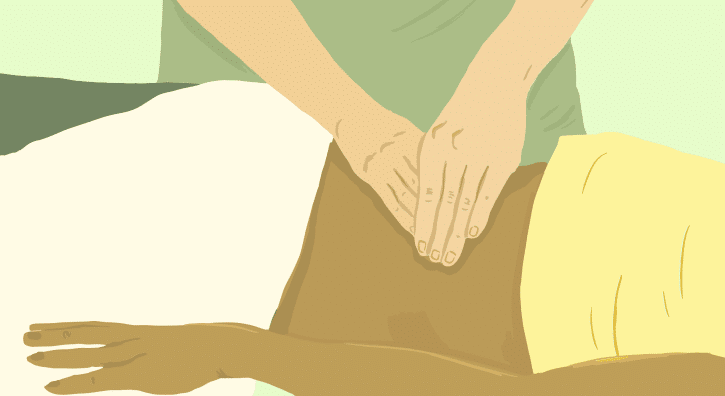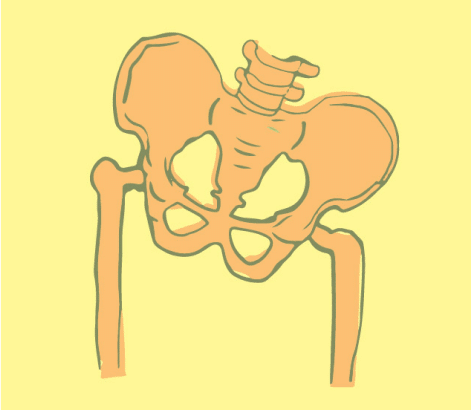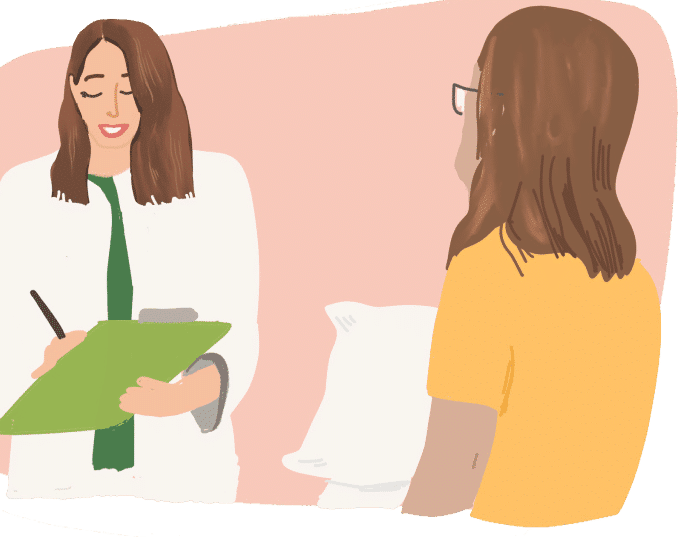

Our physical therapists are vetted during their post-graduate training in pelvic floor physiology and anatomy to accurately meet patients’ pelvic health needs and provide intelligent treatment. Pelvic floor physical therapy is a newer, but increasingly acknowledged area of physical therapy, and Pelvic Health Rehabilitation Center is proud to be a leader in the field. Our physical therapy experts have specialized training in pelvic health, our priority is the overall wellness of patients’ bodies and minds.
Our San Francisco physical therapists help patients move past symptoms that are caused by dysfunctions within the nervous, musculoskeletal, urologic, reproductive, and gastrointestinal systems. Generally, pelvic health issues fall into one of four categories:
- Bladder Dysfunction
- Bowel Dysfunction
- Sexual Dysfunction
- Pelvic Pain
There are many reasons pelvic floor symptoms may develop, including surgery, injuries, trauma, pregnancy, medication-induced, and menopause along with many others. If you recognize any of these symptoms, contact our team or explore the site to find detailed information.
Our physical therapists are vetted during their post-graduate training in pelvic floor physiology and anatomy to accurately meet patients’ pelvic health needs and provide intelligent treatment. Pelvic floor physical therapy is a newer, but increasingly acknowledged area of physical therapy, and Pelvic Health Rehabilitation Center is proud to be a leader in the field. Our physical therapy experts have specialized training in pelvic health, our priority is the overall wellness of patients’ bodies and minds.
Our San Francisco physical therapists help patients move past symptoms that are caused by dysfunctions within the nervous, musculoskeletal, urologic, reproductive, and gastrointestinal systems. Generally, pelvic health issues fall into one of four categories:
- Bladder Dysfunction
- Bowel Dysfunction
- Sexual Dysfunction
- Pelvic Pain
There are many reasons pelvic floor symptoms may develop, including surgery, injuries, trauma, pregnancy, medication-induced, and menopause along with many others. If you recognize any of these symptoms, contact our team or explore the site to find detailed information.
Symptoms
Bladder Symptoms
- Urinary urgency, frequency, hesitancy, and pain in the absence of infection
- Weak urinary stream
- Leaking urine (incontinence)
- Urethra and bladder pain
- Pain before, during, or after urination
- Nocturia (nighttime urination)
- Pediatric bedwetting (nocturnal enuresis)
*Cisgender Male Sexual Symptoms
- Erectile dysfunction: poor quality, inability to achieve an erection, inability to maintain erection, premature ejaculation
- Decreased force or inability to ejaculate
- Climacturia (incontinence with orgasm)
- Post ejaculatory pain: tip and/or shaft of penis, perineum, scrotum
- Discoloration in penis/scrotum/perineum
*Cisgender Male Pelvic Pain Symptoms
- Burning, itching, aching, or other types of pain in the penis, scrotum, testicles, perineal, and/or anal area
- Pain with sitting, certain types of exercises, and certain types of clothing
- Post ejaculatory pain in the penis, scrotum, and/or perineum
- Gastrointestinal distress, bloating, and/or constipation
- Symptoms can be provoked, such as in response to ejaculation or exercise, or unprovoked and spontaneous
- Symptoms may be intermittent or constant
Bowel Symptoms
- Straining to evacuate stool
- Adult and pediatric constipation
- Need for excessive toilet paper
- Fecal and/or gas leakage and incontinence
- Hemorrhoids and fissures
- Pain before, during, or after bowel movements
- Anal/rectal pain, burning, or itching
*Cisgender Female Sexual Symptoms
- Inability or decreased ability to lubricate
- Pain upon vaginal penetration, with deep penetration only, and/or continuous pain with penetration
- Clitoral pain, hypersensitivity to touch
- Pain and/or burning after sexual contact
- Inability to orgasm, diminished orgasm
- Urinary incontinence during sexual activity
- Climacturia (incontinence with orgasm)
*Cisgender Female Pelvic Pain Symptoms
- Burning, itching, aching, or other types of pain in the vulva, vagina, perineal, and/or anal area
- Pain with intercourse, hypersensitivity when wearing pants and/or underwear, and pain with sitting
- Exercise may provoke or exacerbate symptoms
- Abdominal bloating, gastrointestinal distress, and constipation
- Symptoms can be provoked, meaning with penetrative intercourse or tampon insertion, or unprovoked and spontaneous
- Symptoms can be intermittent or constant
Transgender Pelvic Health Symptoms
- Pain from surgical scars
- Pain with vaginal penetration
- Inability to achieve vaginal penetration
- Difficulty or inability to achieve orgasm
- Urinary dysfunction includes urgency, frequency, hesitancy, incontinence, and spraying
- Pelvic and low back pain

Treatment:
How We Can Help You

Anyone who recognizes these symptoms is urged to schedule a pelvic floor physical therapy evaluation with our specialists to start their recovery process. To begin your treatment process, our physical therapists will review any previous diagnoses you have had, along with history, symptoms, and the effectiveness of your past treatments. During this evaluation, the PT will also be observing your tissues, muscles, joints, nerves, and movement patterns to create a thorough assessment. This assessment will review the cause of your symptoms and detail short-term and long-term treatment goals. After your physical therapist has completed your initial examination, they will share their results with you, as well as a recommended treatment plan. Pelvic floor treatments are often scheduled twice a week for approximately twelve weeks, allowing us to resolve issues from the source.
Our team is compassionate towards your situation and understands that most individuals go through a frustrating line of ineffective processes before connecting with us. PHRC is devoted to assisting patients with their full recovery and helping them live pain-free and happy!

Treatment:
How We Can Help You
Anyone who recognizes these symptoms is urged to schedule a pelvic floor physical therapy evaluation with our specialists to start their recovery process. To begin your treatment process, our physical therapists will review any previous diagnoses you have had, along with history, symptoms, and the effectiveness of your past treatments. During this evaluation, the PT will also be observing your tissues, muscles, joints, nerves, and movement patterns to create a thorough assessment. This assessment will review the cause of your symptoms and detail short-term and long-term treatment goals. After your physical therapist has completed your initial examination, they will share their results with you, as well as a recommended treatment plan. Pelvic floor treatments are often scheduled twice a week for approximately twelve weeks, allowing us to resolve issues from the source.
Our team is compassionate towards your situation and understands that most individuals go through a frustrating line of ineffective processes before connecting with us. PHRC is devoted to assisting patients with their full recovery and helping them live pain-free and happy!
2000 Van Ness Avenue, Suite 603, San Francisco, California 94109, CA
PHRC expanded into San Francisco in 2018. We are happy to serve our patients in this part of Los Angeles and Ventura Counties! Free parking is available for our patients in the parking lot attached to our building.

2000 Van Ness Avenue, Suite 603, San Francisco, California 94109, CA
PHRC expanded into San Francisco in 2018. We are happy to serve our patients in this part of Los Angeles and Ventura Counties! Free parking is available for our patients in the parking lot attached to our building.

Frequently Asked Questions
Pelvic floor physical therapy is an often overlooked component of physical therapy. In pelvic floor therapy, specialists focus on rehabilitating pelvic floor muscles that are causing dysfunction or discomfort.
During your evaluation, which will be conducted during your first appointment, our pelvic floor specialist will begin with a patient interview to collect a full history of your symptoms and why you reached out. This initial interview will let our pelvic floor physical therapists improve their understanding of your symptoms and the impact they have had on your life. In addition to that, your evaluation will let us improve your understanding of pelvic floor dysfunction. The interview also allows us to gain the necessary information to know the most essential areas of the body to evaluate as it is impossible to examine the entire person on day 1. The examination consists of a visual exam looking at posture, alignment, and movement patterns followed by a manual evaluation of the external structures. Typical areas of the body we palpate include the abdomen, inner thighs, bony pelvis (i.e. sit bones, pubic bones, hip bones, etc.), and buttocks. We are looking for myofascial trigger points, tight muscles, connective tissue restrictions, joint dysfunction, imbalances from side to side, and other impairments around the areas of pain/dysfunction. While conducting the internal pelvic floor examination, our experts are observing your trigger points, muscle tone, strength, and motor control. Some of the main symptoms that we look for are pelvic organ prolapse, dermatologic variations, skin lesions, and diastasis recti ( separating of organs in the midsection of your abdomen). We also screen patients for irritability of the peripheral nerves that are located in the pelvis along with the integrity of vaginal and anal tissue. Throughout the evaluation, short-term and long-term goals are written down for the patient to reach. Typically the duration of a physical therapy treatment plan can last between a few weeks to several months, or longer, depending on the severity of the situation. We use short incremental goals to justify our treatments and collectively achieving the short-term goals results in achieving the patient’s long-term goals. At the end of the appointment and after the patient is once again dressed, we review what we found. It is important to us that our patients understand what we found, how we plan to help them with the problem areas, and how we are collaborating with their other providers.
Manual therapy techniques are often included in typical treatments, which may include internal and external trigger point release, connective tissue manipulation, neural mobilizations, joint mobilizations, and neuromuscular re-education, depending on the patients’ needs at the time. The primary focus of our treatments involves the pelvic floor muscles and girdle but daily postures, breathing patterns, movements, and behaviors are incorporated as needed. We focus on the muscles of the pelvic girdle and pelvic floor; however, we incorporate daily postures, movements, breathing patterns, and behaviors. For instance, if a patient has constipation, we will spend time teaching them why bowel movements are difficult for them, how we will help address the impairments, and what they can do at home to help. Some people will need more help with neuromuscular control and some people may benefit more from manual therapy. Generally speaking, manual therapy is often part of a treatment session for people with pelvic pain whereas coordination and strengthening may be more involved in post-operative rehabilitation or for people with low-tone pelvic floor disorders. However, “hybrid” situations do exist and are treated accordingly.
Each treatment session is customized to benefit the needs of our patients and provide the clearest path to recovery. Our specialists hone in on the primary factors that are contributing to your limitations. This means that one treatment may incorporate more manual therapy while the next treatment may be focused on re-training your habits, postures, and movements. Typically, each treatment session requires some internal manual therapy or manual biofeedback since these conditions almost always produce some form of pelvic floor dysfunction and this is the best way to understand how your pelvic floor muscles are working.
Near the end of each appointment, we review what the patient is working on at home, why these are the areas of focus, and we may add new exercises or changes to their home program.
Our initial consultations are $285/hour, follow-ups are $255/hour.
Your initial consultation with PHRC will begin with an evaluation, which our specialists use to conduct the patient interview. During this interview, we seek to better our understanding of your medical history and why you are seeking treatment with a pelvic specialist. The interview portion helps us gather background data, helps us understand the impact the problem has had on the patient’s life and their understanding of pelvic floor dysfunction. The interview also allows us to gain the necessary information to know the most essential areas of the body to evaluate as it is impossible to examine the entire person on day 1. The examination consists of a visual exam looking at posture, alignment, and movement patterns followed by a manual evaluation of the external structures. Typical areas of the body we palpate include the abdomen, inner thighs, bony pelvis (i.e. sit bones, pubic bones, hip bones, etc.), and buttocks. We are looking for myofascial trigger points, tight muscles, connective tissue restrictions, joint dysfunction, imbalances from side to side, and other impairments around the areas of pain/dysfunction. During the internal pelvic floor muscle exam, we are evaluating for muscle tone, trigger points, strength, and motor control. We examine for diastasis recti, pelvic organ prolapse, skin lesions, and dermatologic changes. Additionally, we are screening for irritability in the peripheral nerves of the pelvis, and vaginal and anal tissue integrity. Throughout the evaluation, short-term and long-term goals are written down for the patient to reach. Typically the duration of a physical therapy treatment plan can last between a few weeks to several months, or longer, depending on the severity of the situation. By using short-term, incremental goals as a focus during treatments, we are able to work towards achieving patient’s larger aspirations and their complete health. After pelvic floor physical therapy sessions have ended and you have had time to redress, your PT will discuss their findings. By ensuring that our patients understand findings and the proper course of action, we can create an accurate plan of action for addressing symptoms and collaborating with other medical providers you may be working with.
The benefits of pelvic floor physical therapy can be extended to everyone, but certain symptoms should urge you to schedule a consultation with our specialists. Pelvic floor therapy is highly recommended for anyone experiencing:
-male pelvic pain (Chronic Pelvic Pain Syndrome/male pelvic pain, Nonbacterial chronic prostatitis, Interstitial Cystitis/Painful Bladder Syndrome, Pudendal Neuralgia, Tailbone pain/coccygodynia, Sacral pain, Abdominal and groin pain, Testicular pain, Perineal pain, Penile pain, Anal/rectal pain, Post-ejaculatory pain)
-female pelvic pain (Vulvodynia/Vestibulodynia, Interstitial Cystitis/Painful Bladder Syndrome, Pudendal Neuralgia, Endometriosis, Clitoral pain, Tailbone pain/coccygodynia, Abdominal pain, Sacral pain, Anal/rectal pain, Dyspareunia/pain with intercourse)
-bowel dysfunction (Constipation, Hemorrhoids/fissures, Difficulty evacuating, Dyschezia/painful bowel movements, Fecal Incontinence, Anal pain, anal burning, Pelvic Organ Prolapse)
-bladder dysfunction (Stress Urinary Incontinence, Urge Urinary Incontinence, Post-prostatectomy urinary incontinence, urinary urgency/frequency, dysuria, retention, hesitancy, nocturia, Associated pelvic pain diagnoses: Interstitial Cystitis, Chronic Pelvic Pain Syndrome/male pelvic pain, Pelvic Organ Prolapse)
-currently pregnant or postpartum
-going through post-surgical rehab (Pelvic reconstruction, Pudendal Nerve Decompression, Gender affirmation procedures, Laparotomy/laparoscopy, Prostatectomy, Cesarean section, Vestibulectomy, Hernia Repair)
-Pelvic Organ Prolapse
Your evaluation and every following appointment will be one hour long. After your initial evaluation, the first appointment will typically start with your pelvic floor physical therapist answering any questions you may have. After your questions have been answered, your physical therapy appointments will begin with reviewing symptoms that you have had since your last treatment session along with any changes you made to your exercise regimen or daily habits to track their impact.
The physical therapist will often have specific inquiries about current symptoms. For example, if the person has pain with urination, we will ask detailed questions about the nature of the pain, intensity, how long it lasted and if the treatment or exercise provided relief. The answers to these questions help us decide what to tackle during each session.
Manual therapy techniques including trigger point release externally, trigger point release internally, joint mobilizations, neuromuscular re-education, neural mobilizations, and connective tissue manipulation may be used in typical pelvic floor therapy sessions. Our specialists devote most effort towards the muscles in the pelvic floor and girdle, but also include movements, daily postures, breathing patterns, and behaviors to support well-rounded patient health.
For instance, if a patient has constipation, we will spend time teaching them why bowel movements are difficult for them, how we will help address the impairments, and what they can do at home to help. Some people will need more help with neuromuscular control and some people may benefit more from manual therapy. Generally speaking, manual therapy is often part of a treatment session for people with pelvic pain whereas coordination and strengthening may be more involved in post-operative rehabilitation or for people with low-tone pelvic floor disorders. However, “hybrid” situations do exist and are treated accordingly.
Each treatment session at PHCR is tailored to accommodate patients and provide the best result. Starting with the information provided during your initial consultation, our specialists will aim to resolve the primary factors that are causing your limitations. This entails flexible treatments, which may result in manual therapy techniques during one session and a totally different treatment the next week, where we may focus on postures and movements or re-training habits. Manual biofeedback or internal manual therapy is usually part of each treatment session because they offer a window into the state of your pelvic floor muscles, which helps us treat the dysfunction.
Near the end of each appointment, we review what the patient is working on at home, why these are the areas of focus, and we may add new exercises or changes to their home program. As previously mentioned, the patient is a key player in the road to recovery so the things they do at home are just as important as the time they spend in the clinic.
